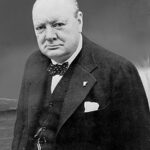History

The modern necktie traces its origins to the cravat, which first gained popularity in 17th century France. A group of Croatian mercenaries in the service of France were wearing cravats when they were presented to the French royalty. A young Louis XIV was present and began wearing them. Later that century Charles II (returning from exile in France) brought them to England and the fashion quickly spread.
Our modern neckties evolved during the industrial revolution. The thin profile allowed them to remain tied for longer periods of time and to be easier to tie. Today’s necktie was truly born in 1923, though, when Jesse Langsdorf patented his tie constructed of three pieces. Langsdorf’s major innovations were cutting the fabric diagonally against the grain (along the bias) to allow for more elasticity, and adding a lining and a loose “slip stitch” to help the tie keep its shape after multiple twistings and knottings.
Today, ties retain few of their original functions. It’s speculated that the Chinese and Romans used colored scarves to show allegiance or membership; many schools and military units today use ties for this same purpose. Cravats were at one time used to protect the shirt from stains, but today’s ties are too thin for this purpose. Some speculate that ties are for hiding the buttons and placket of a shirt or for directing an observer’s attention upward or downward. There’s no way to know for sure, but for now the tie is an essential part of most men’s wardrobes.
Choosing a Tie

The size of tie we should wear can generally be determined by the size of our lapel or collar. A wide jacket lapel or a larger collar would be better complemented by a tie with more width, just as a thinner lapel and collar would look better with a thinner tie. In general, there is a 1:1 ratio between the width of the lapel and the width of the tie. If we are wearing a bow tie, we don’t have to worry about this.

The color of our tie can be hard to choose. If we’re trying to match our ties to our outfits, then check back to my guide on color. An easy rule to remember is not to match the tie precisely to the color of our shirts. We want to choose a color that is complementary or analogous to our shirts instead. The color of our tie can also serve a function. A red “power tie,” for instance, is a good choice for speakers because the red tends to draw the eye towards the speaker.
When it comes to pattern, things become a little bit trickier. With patterns, we don’t want the exact same pattern on more than one article of clothing. If our shirts are striped, it’s okay to wear a striped tie — we just need to make sure that one set of stripes is thicker or thinner than the other. Pattern matching is a tricky subject that I will cover more thoroughly in a future article.
Choosing a Knot
When choosing a knot for our ties, the most important thing to consider is the spread of the collar. If the spread is small, then we need a thinner knot because a larger knot would get lost under the collars. If our collars are spread wide, then our tie knot should be larger to fill the space. Larger knots also convey more formality than smaller knots, as do symmetrical knots. Smaller knots and asymmetrical knots are more casual and informal.
I’ve included images from Ties.com on how to tie the four most popular knots: the four-in-hand, the half-Windsor, the Windsor, and the bow tie. Although the four-in-hand is the easiest to tie, it is the least formal. The Windsor is the hardest of the three necktie knots to tie, but it is the most formal.



The bow tie has traditionally been associated with formal occasions — such as black tie or white tie events — but it is perfectly acceptable for semi-formal or even casual occasions. Although they might be associated with the nerdy subculture, the bow tie good for whenever we have the confidence to wear it.

Resources used for this article:
http://www.todayifoundout.com/index.php/2013/03/the-origins-of-the-neck-tie/
https://books.google.com/books?id=4GQDAAAAQAAJ&printsec=frontcover#v=onepage&q&f=false
https://books.google.com/books?id=CjRcAAAAQAAJ&printsec=frontcover#v=onepage&q&f=false
http://www.invention-protection.com/pdf_patents/pat1447090.pdf
http://www.csmonitor.com/2004/0615/p18s02-hfks.html
https://en.wikipedia.org/wiki/Necktie
http://www.ties.com/blog/tie-anatomy
http://www.ties.com/how-to-tie-a-tie
http://www.ties.com/man-academy
http://www.shirtsmyway.com/articles/different-ways-how-to-tie-a-tie-knots.php











